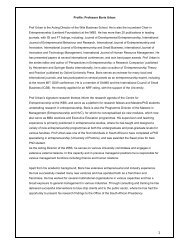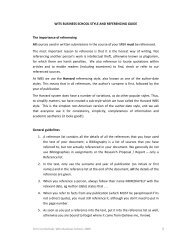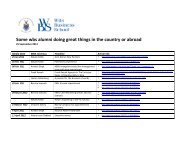How to write your Research Problem Statement at WBS
How to write your Research Problem Statement at WBS
How to write your Research Problem Statement at WBS
You also want an ePaper? Increase the reach of your titles
YUMPU automatically turns print PDFs into web optimized ePapers that Google loves.
Therefore the <strong>to</strong>pic of this research is <strong>to</strong> identify the role of corpor<strong>at</strong>e social<br />
responsibility in empowering small business.<br />
The <strong>Problem</strong> <strong>St<strong>at</strong>ement</strong> was constructed by tightening up the context <strong>to</strong> elimin<strong>at</strong>e repetition,<br />
correcting the grammar, removing the personal pronoun “my” and rephrasing it in the passive<br />
voice. In addition, the st<strong>at</strong>ement “. . . establish IF large companies . . .” was rephrased <strong>to</strong><br />
“whether and how” because “if” has a yes / no answer (not OK) and “whether and how”<br />
requires a detailed, contextualised and rich response (OK).<br />
<strong>Problem</strong> st<strong>at</strong>ement:<br />
The intention of this research is <strong>to</strong> establish the purposes for which large corpor<strong>at</strong>e are<br />
using their CSI / CSR programmes, with particular reference <strong>to</strong> whether and how they are<br />
using such programmes <strong>to</strong> empower small businesses, and, further, <strong>to</strong> g<strong>at</strong>her ideas <strong>to</strong><br />
expand such investments.<br />
Sub‐problem 1:<br />
Establish the purposes for which large corpor<strong>at</strong>es are using their CSI / CSR programmes<br />
Sub‐problem 2<br />
Identify ways in which large corpor<strong>at</strong>es are using CSI / CSR programmes <strong>to</strong> empower small<br />
businesses, and further, <strong>to</strong> g<strong>at</strong>her ideas for expanding such investments<br />
8. Your sub‐problems should NOT be steps in the process of finding the solution <strong>to</strong> <strong>your</strong> <strong>Research</strong><br />
<strong>Problem</strong>. This is a common and understandable error. The example below shows the sub‐<br />
problems <strong>to</strong> be steps in the process th<strong>at</strong> the student intends <strong>to</strong> follow in the research (these<br />
can be described in the methodology chapter). They are not invalid ‐ they are just not sub‐<br />
problems.<br />
Main <strong>Problem</strong><br />
Compare the characteristics of the South African and Ghanaian home loan markets in<br />
rel<strong>at</strong>ion <strong>to</strong> consumer home loan choice criteria, home finance availability on both markets,<br />
home loan administr<strong>at</strong>ion, success and hindering fac<strong>to</strong>rs, risks in pricing of home finance,<br />
the st<strong>at</strong>us and causes of home loan default in both markets and <strong>to</strong> predict the way forward<br />
for both markets.<br />
Sub‐problems<br />
1. Analyse consumer choice criteria in both home loans markets<br />
2. Assess the availability and accessibility of home loans.<br />
3. Establish the difficulties encountered in home loan administr<strong>at</strong>ion<br />
4. Identify the risks in home loan pricing and the effect of infl<strong>at</strong>ion on pricing<br />
5. Determine the st<strong>at</strong>us and causes of home loan default<br />
6. Forecast the future of the South African and Ghanaian home loan markets<br />
Carmichael, T. (2009), Wits Business School, Johannesburg, South Africa 3













